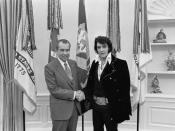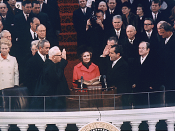The Selling of the President 1968 by Joe McGinniss In literature, various books discuss the theme of advertising. These stories describe the selling of objects, people, or ideas. According to The Selling of the President 1968, a book written by Joe McGinniss, a presidential candidate is required to Asell@ himself to the public to win an election. This story describes the final weeks of Richard Nixon=s campaigning for the presidency and how he utilizes the strengths of television. In the beginning of the book, the author compares Nixon to a celebrity or actor; he must demonstrate himself as a sincere, lovable person, rather than present his ideas to the people. Later in the book, Nixon stars in a television show where a select group of people asks him questions pertaining to his ideas for presidency. Finally, Nixon=s commercials for his campaign are produced in such an intricate manner, that they provoke deep and profound emotions in the viewers.
All of these techniques surmount to the perfect advertisement of a politician. While the essential theme in this book is the selling of a candidate, The Selling of the President 1968 explains the beginning of advertising a presidential candidate through television by creating an image of the person, concern in the interest of the people, and sympathy for the voters.
First, the primary theme of Selling of the President 1968 is the process of advertising the candidate. For his second attempt at presidency, Richard Nixon is broadcasted on television to show the United States how his character has changed since the previous election. In the beginning of the book, the reader is introduced to Nixon attempting to create commercials for his campaign. For each commercial, Nixon is required to appear as an inviting person to the viewer. For example, he likes to lean against or sit on the edge of a desk, for Nixon felt this stance made him seem more informal. Furthermore, his advertising is a very ideal method, for advertisers and politicians realize that A. . . the citizen did no so much vote for a candidate as make a psychological purchase of him . . .@ (27) Finally, Nixon has various types of advertising methods. For example, he has commercials that create extreme emotional impacts upon the viewers. Also, he has a television show, where a select group of people ask him questions, which helps promote his ideas for presidency. These different methods help Nixon win the election. Jim Sage, a supervisor of the advertisements, states, AWe=re moving into a period where a man is going to be merchandised on television more and more . . . The pupil sits home and watches Gunsmoke and when they=re fed this pap about Nixon they think they=re getting something worthwhile.@ (115) Richard Nixon creates an indistinguishable difference between advertising and promoting one=s campaign by using television.
Being an extremely important objective to a televised campaign, the image of a candidate must be brought to perfection to win an election. To win the presidency, Richard Nixon realizes the necessities. A . . . he discussed improvements that would have to be made Cnot upon Nixon himself, but upon the image of him which was received by the voter. That there is a difference between the individual and his image is human nature.@ (26) The voters of the United States do not consider the life of a candidate. Instead, they deliberate over his or her appearance or image to determine whom to vote for in the election. Also involving the image issue, candidates are required to become Acelebrities@ when they advertise on television.
AOn television it matters less that he does not have ideas. His personality is what the viewers want to share. He need be neither statesman nor crusader; he must only show up on time. Success and failure are easily measured: how often is he invited back? Often enough and he reaches his goal Cto advance from >politician= to >celebrity,= a status jump bestowed by grateful viewers who feel that finally they have been given the basis for making a choice.@ (29) In his campaign, Richard Nixon is more concerned over his appearance on television, rather than his ideas. This logic indicates that Nixon has to be an Aactor@ to the public, which, in result, causes more votes for him from the easily deceived public. Creating the image of a candidate is a requirement for the likelihood of winning an election.
Furthermore, for a candidate to be extremely successful in an election, one must display concern in the interests of the people. In the beginning of The Selling of the President 1968, Nixon prepares a few commercials for his campaign. In all of these commercials, he has a quality that demonstrates his devotion toward the topics he discusses. ANixon had refused the teleprompter from the start. He kept all the figures . . . He kept them all in his head . . .@ (13) Usually, a candidate uses a teleprompter when he or she does a commercial, for they cannot memorize the information. Yet, because Nixon demonstrates an incredible dedication to the people, he memorizes the data. Also, within these creations of the commercials, Nixon decides to make various commercials for different regions. As an example, Nixon decides to voice his opinion in a commercial on the New York City teacher=s strike. AThis had not been scheduled. It was Nixon=s own idea . . .@ (22) Nixon believes that he must announce his opinion on the topic of the teacher=s strike, even though it could mean the loss of votes. Because Nixon is willing to represent his thoughts and remember important information for commercials, he displays a concern in the interests of people, an important characteristic for a successful candidate.
Finally, being a profoundly significant objective to a televised campaign, the creation of sympathy in the voters is essential to win an election. Nixon=s advertising management uses an excellent way to create this feeling among the voters by a type of commercial, where his acceptance speech would be accompanied with flashing pictures.
AThe flashing pictures would be carefully selected to create the impression that somehow Nixon represented competence, respect for tradition, serenity, faith that the American people were better than people anywhere else, and that all these problems others shouted about meant nothing in a land blessed with the tallest buildings, strongest armies, biggest factories, cutest children, and rosiest sunsets in the world. Even better: through association with the pictures Richard Nixon would become these very things.@ (85) Richard Nixon=s commercials evoke feelings of powerfulness, which creates the sympathetic relationship of the viewer and the candidate. This special connection causes the people to vote for Nixon. Because of these effective commercials, a part of the televised campaign, Nixon is more likely to win the election.
In conclusion, the essential theme of The Selling of the President 1968 is the selling of a candidate. Yet, also, the book explains the beginning of advertising a presidential candidate through television by creating an image of the person, concern in the interest of the people, and sympathy for the voters. In the Aselling@ of a candidate, the person is reflected by television to the voters, where only the person=s actions and looks create a difference. Also, the image of this person is crucial, for a Acelebrity@ inspires the people. Moreover, the candidate has to display concern for the issues of the voters. Finally, this person is required to have compassion for the voters and demonstrate how he or she can help them. As Sarah Bernhardt, a French actor, once said, AThe monster of advertisement . . . is a sort of octopus with innumerable tentacles. It throws out to right and left, in front and behind, its clammy arms, and gathers in, through its thousand little suckers, all the gossip and slander and praise afloat, to spit out again at the public.@ The use of television for advertising a candidate must be checked in scrutiny for every detail, yet the end result produces a sensation.





